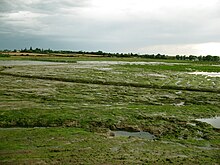Managed retreat
Politicians, insurers, and residents are increasingly paying attention to managed retreat from low-lying coastal areas because of the threat of sea level rise due to climate change.
In the United Kingdom, managed realignment through removal of flood defences is often a response to sea-level rise exacerbated by local subsidence.
[11] According to University of Southampton researchers Matthew M. Linham and Robert J. Nicholls, "one of the biggest drawbacks of managed realignment is that the option requires land to be yielded to the sea.
One of its benefits is that it can help protect land further inland by creating natural spaces that act as buffers to absorb water or dampen the force of waves.
Following this guidance, the UK's biodiversity action plan aims to prevent net losses to the area of salt marsh present in 1992.
One of the major reasons cited for the slow pace of current salt marsh restoration in the UK[14] is the uncertainty associated with the practice (Foresight).
[20] In other cases, such as Odanah[21] and Soldiers Grove, Wisconsin,[22] or Valmeyer, Illinois,[23] or Isle de Jean Charles, Louisiana the entire community has relocated.
[25] Some areas included in managed retreat are above sea level and are recommended based primarily on estimated engineering costs and by studies financed by the California Coastal Commission itself.
[33] As a result of two climate change related landslides in New Zealand in 2005, the Whakatane District Council began to plan for climate-related migration to the Matata township over the next decade.


